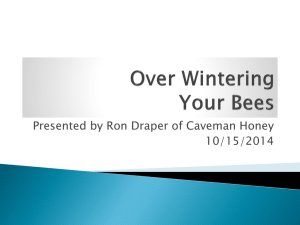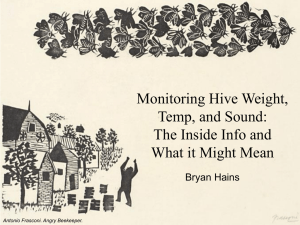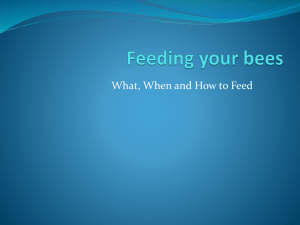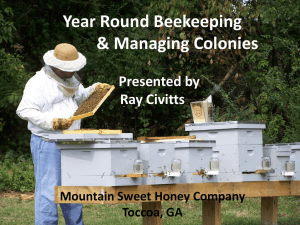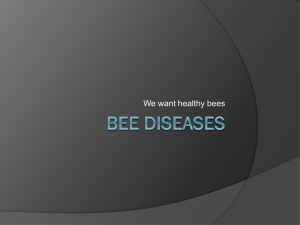Fall and Winter Management by Jack Miller
advertisement
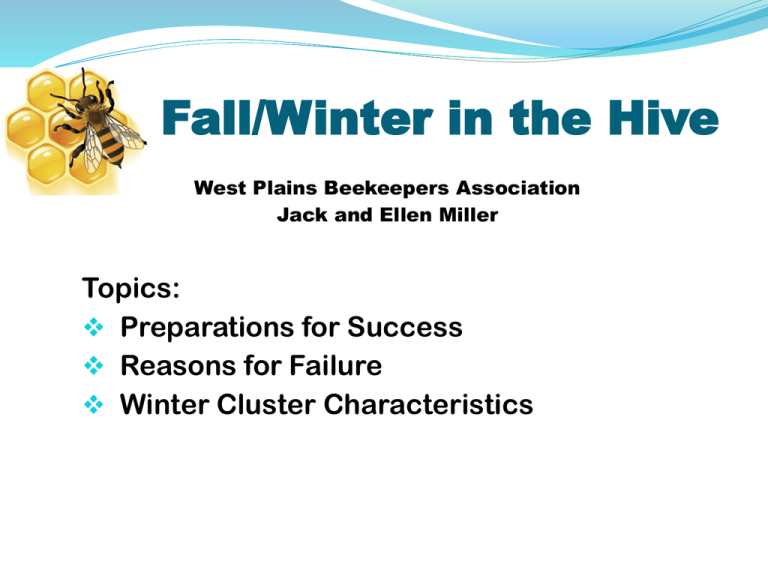
Fall/Winter in the Hive West Plains Beekeepers Association Jack and Ellen Miller Topics: Preparations for Success Reasons for Failure Winter Cluster Characteristics Preparations for Success Consensus: Enough honey and pollen located correctly in hive (approx. 60-80 lbs) Ventilated hive (top and bottom) Enough bees (approx. 6 frames) Productive queen Take Winter loses in the Fall Room in the center for bees i.e. empty cells Protection from invaders (mice, etc.) Hive tilted slightly forward so water runs out Locate hive away from Spring water Fall Preparation Remove any honey supers still on the hives Remove any queen excluders Unite any weak colonies Re-queen colonies that have weak or old queens Destroy any diseased or poisoned colonies Provide for top ventilation Move bees to a sheltered location if necessary Feeding Fall Feeding When Temperatures are above 60 degrees F 2 to 1 sugar to water syrup A 25 pound bag of sugar in 13 pints hot water A paint mixer on a power drill helps Winter Feeding Temperature below 60 degrees Plain granulated sugar on light paper over top bars Allow ventilation around the paper Fondant Preparations for Success #2 Recommendations Generally Agreed To: Stores on the sides of the cluster in the bottom box and above the cluster in the top box Sheltered from the wind South facing for maximum sunlight Top entrance hole Accessible throughout the Winter Differences of Opinion: Need a colony covering 20 frames in a 2 story hive; 130 pound gross weight; 10 pounds of bees 18K - 35% 4.5K - 85% Minimum of 60-80 pounds of honey Equivalent of 4 frames of pollen Entrance NOT blocked with reducer for ventilation Reasons for Failure Starvation Run out of honey/food Honey/food not where it is needed Lack of ventilation (moisture) Too few bees to maintain cluster Over-management of hive Bee's digestive tract compacted Mites Infrared Hives http://www.beebehavior.com/infrared_camera_pictures.php The Winter Cluster Winter Bees Larger hypopharyngeal glands More body fat Size of Cluster is a Function of Temperature +50 F 14 inches +20 F 11 inches -14 F 10 inches -26 F 4 inches Heat Loss is Proportional to Cluster Size Shape is Oblong Sphere Internal Temperature 90 degrees F The Winter Cluster #2 Structure The outside shell of bees or mantel is from 1 to 3 inches thick with the bees filling the spaces between the frames and empty cells. Inside the shell or core the bees are less tightly packed and warmer. They are able to move about and care for brood, queen and to perform maintenance The outside bees rotate with the inner bees based on hunger not temperature. Average 8 days with maximum of 16 days with a full honey stomach. Temperature regulation is by endothermic heat production in the core and insulation control by the mantel. It’s only the cluster temperature that is controlled by the bees – the hive temperature is close to outside temperature. The Winter Cluster #3 Temperature Bees start to cluster at 57 degrees F Bees use winter stores most efficiently at 45 degrees F The lowest temperature the hive can survive depends on how many bees, how many stores, and duration of cold spell In moderate temperature the bees move honey closer to the interior of the cluster In colder temperatures the bees compact but must always maintain contact with honey stores Mantel temperature 48 – 57 degrees Core temperature 64 – 90 degrees. The Winter Cluster #4 Bee Movement Bees will organize the nest in preparation for Winter. During warm spells bees will move supplies to the cluster. Cluster will migrate toward the warm side of the hive when temperature is above 48 degrees. Cluster will follow the heat in the hive up, as supplies are consumed. Cluster size shrinks and expands in response to temperature. The inside of the hive is the same temperature as outside the hive. The Winter Cluster #5 Differences of Opinion Too large a Fall cluster can be detrimental because the bees can go through their stores too rapidly Wrap hive for the winter Significant variations on bee behavior from one race of honey bee to another: When they stop rearing brood How large the winter cluster How soon they begin rearing brood How efficient they are with stores Medication and disease control Winter Schedule August/September – Prepare hive for winter (location, stores, ventilation) October – Any further preparation such as additional feed November/ December – Check for use of feed only if weather permits; clear obstructed ventilation access as needed January -- Brood rearing starts in January as days lengthen; clear obstructed ventilation access as needed February/ March -- Colony inspections on first warm days in late February or March; clear obstructed ventilation access as needed Summary: Fall management of bees is important: Helps the hive over-winter successfully Prepares the hive for nectar flow the following summer Unless the temperature is over 50 degrees F, don’t open the hive Bees normally excrete body waste in flight. If they can’t fly due to long periods of cold temperature, they may defecate in the hive and dysentery might occur Bibliography ABC and XYZ of Bee Culture by A.I. Root Better Beekeeping by Kim Flottum Honey Bee Biology and Beekeeping by Dewey M. Caron The Journal of Experimental Biology “Hot bees in empty broodnest cells: heating from within” by Marco Kleinhenz, Brigitte Bujok, Stefan Fuchs, and Jürgen Tautz Natural Beekeeping by Ross Conrad The Thermology of Wintering Honey Bee Colonies by CHARLES D. OWENS, Agricultural Engineering Research Division, Agricultural Research Service



